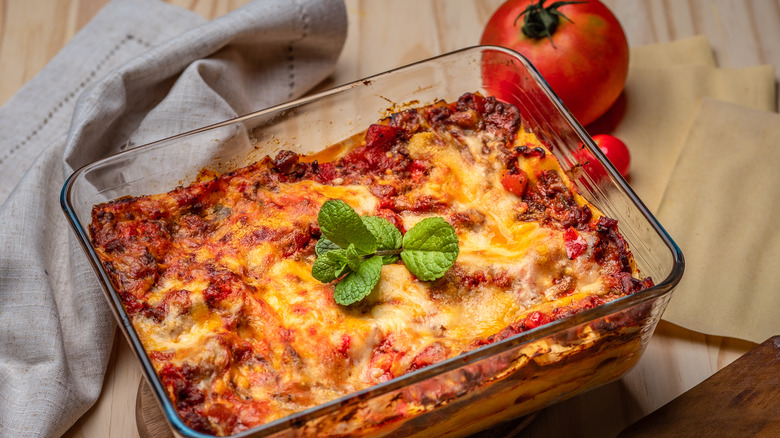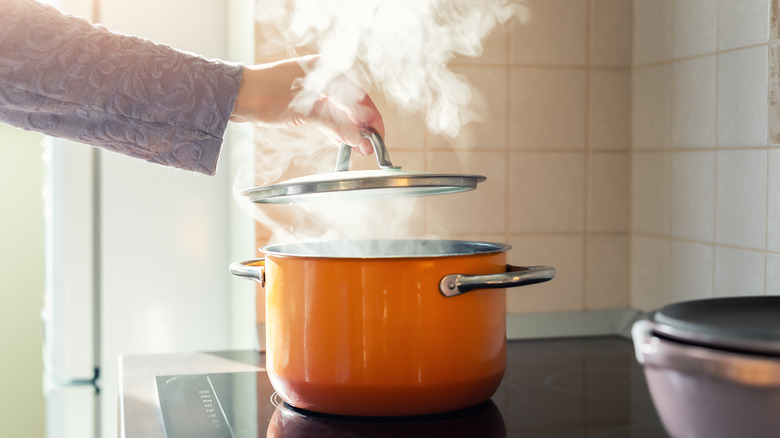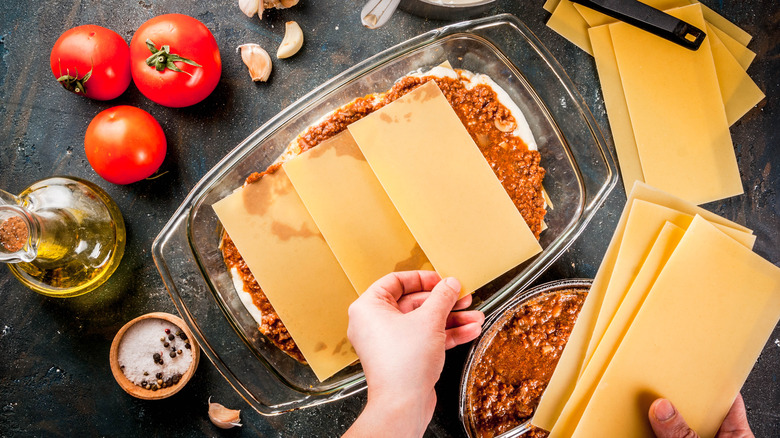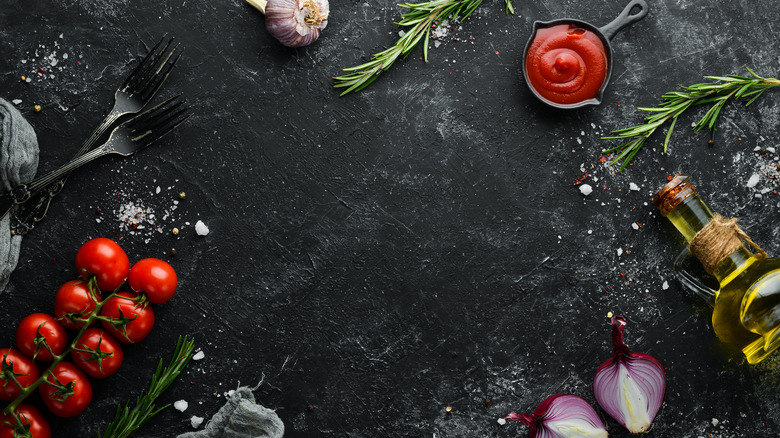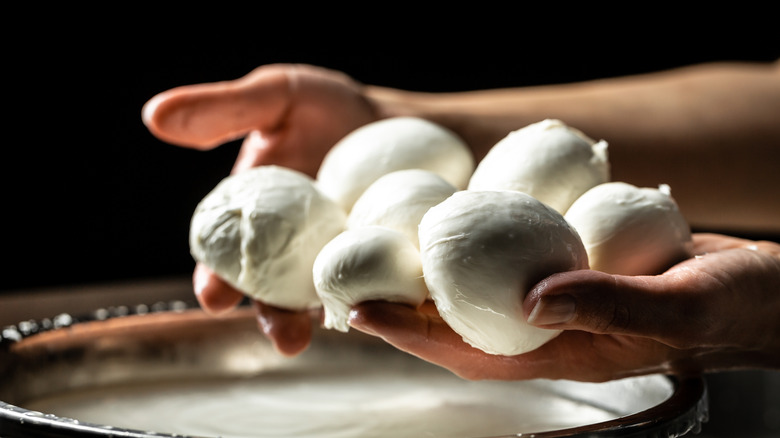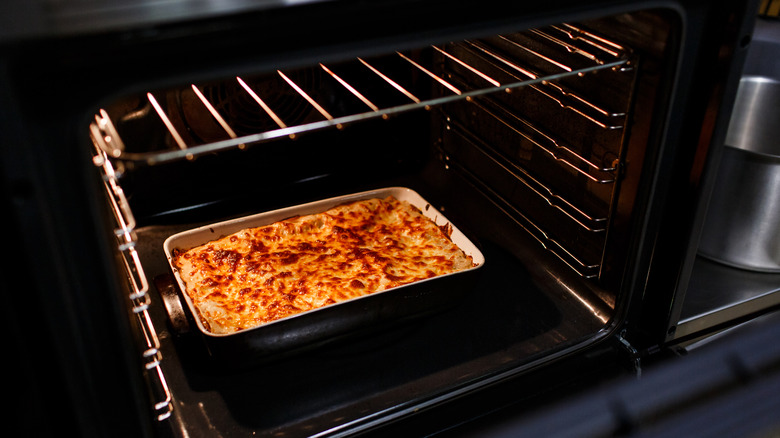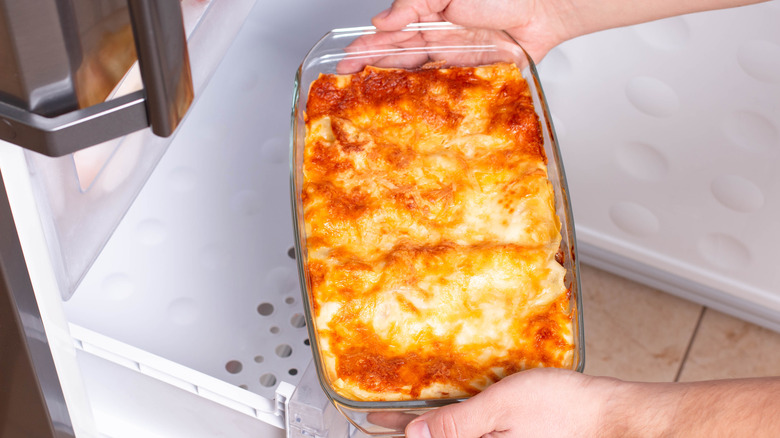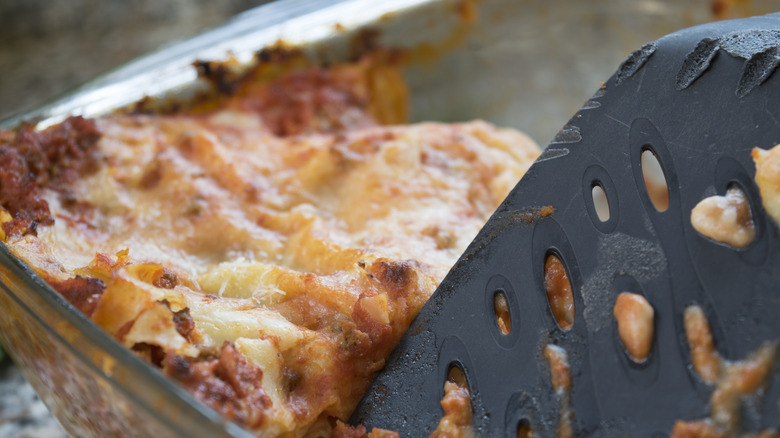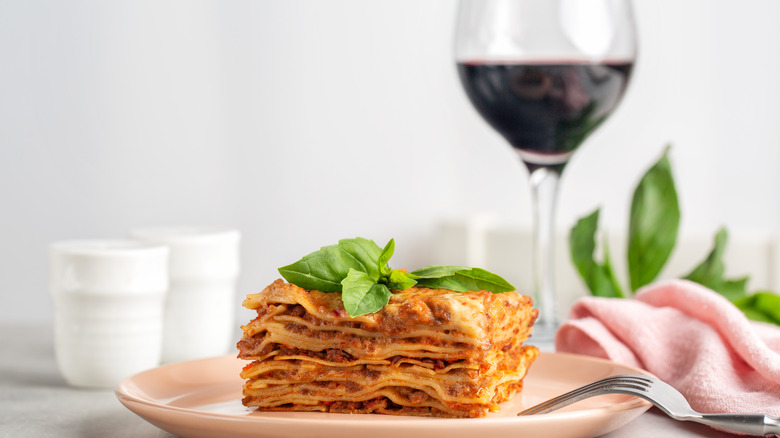10 Tips You Need When Baking Lasagna
If pasta is one of the most comforting dishes known to man, lasagna has to be one of the top contenders in the category. One of the oldest and most popular pasta shapes, lasagna is usually shaped like wide ribbons or rectangles. The dough, made from flour and eggs, is rolled into thin sheets, neatly cut, boiled, drained, and placed on several layers with fillings such as meat, cheese, or vegetables. There are several local varieties of this beloved Italian specialty, hailing from regions such as Emilia Romagna (where it originated, according to La Cucina Italiana), Naples, and Venice.
Cooking an excellent lasagna is no easy feat, as it involves skills such as handling the sticky sheets, perfecting the sauce, and calculating the ideal number of layers. But fear not. By following these steps, you'll better understand what makes great lasagna and won't ever need to buy the frozen stuff again.
Gather your tools
Before you get to work, you must ensure you have the right tools. First, if you're going to go full old-school nonna on this mission and want to make the pasta from scratch, you'll need a large wooden board and a wooden rolling pin to roll the dough to smooth perfection. A nice, sharp knife will help you slice the dough into ribbons.
This journey also requires a couple of large pots: One for boiling the noodles (should you decide to go for no-boil noodles, you can skip this part) and another one for making the sauce. A roll of tin foil is important for avoiding dryness during baking, and you're also going to need a couple of spatulas for spreading the sauce on the lasagna layers and for serving. And lastly, don't forget a cheese grater so that you can sprinkle the dish with lots of high-quality Parmiggiano!
Choose the noodles
As we just mentioned, making lasagna sheets from scratch is always an option for the adventurous and willful home chef. This recipe will require eggs, flour, salt, and a considerable amount of upper body strength. However, if this first step is not in your plans, some decisions will still be made in the noodle realm.
First, you've got to choose between fresh and boxed pasta. You can find fresh pasta at your local deli or gourmet store. If you're going for boxed pasta, grocery stores usually carry trusted brands like Barilla.
Now, when you choose boxed noodles, there are two more possibilities: Traditional dry pasta sheets that need to be boiled before you place them on the dish, or no-boil, or "oven ready" (the kind that you put raw into the baking dish and it comes out cooked from the oven). If you use regular dry pasta sheets, remember to use lots of water and boil the noodles in batches, so they don't stick together in the pot. Stir them and check them regularly to make sure they are al dente. Otherwise, they'll soften too much when they're in the oven.
Layers, layers, layers
The amount of layers in lasagna is up to the chef, but it's essential to strike a balance between the dish's main elements: noodles, sauce, and other fillings. Sure, a 10-layer lasagna will look impressive, but you don't want the final result to taste just like pasta noodles. To achieve this ideal balance, there are a few tricks to learn.
First, you want to cover the bottom of your dish with sauce before adding anything else; this will ensure that the lasagna doesn't stick to the bottom when it's time to serve it. Next, add your first layer of lasagna noodles, followed by a layer of your filling, such as Bolognese. Repeat these steps, alternating between noodles and filling, and remember to spread the filling out carefully, making sure you cover the entire surface of the pasta layer.
A final trick, via Mashed, is to build your final layer with pasta, which will make serving much easier. Just top that with mozzarella or the cheese your recipe calls for, and you'll have lasagna bubbling with cheesy goodness.
Experiment with recipes and ingredients
Like pretty much all its pasta siblings, lasagna is incredibly versatile. This means you can test your skills with traditional recipes like lasagna Napoletana, which features meatballs, salami, ricotta, and hard-boiled eggs and is traditionally eaten during Carnevale. You should always try making classic lasagna Bolognese with ground beef and pancetta.
But lasagna also allows for plenty of experimentation, so get inspired and mix and match fillings like beef, sausage, or pork; cheeses like mozzarella, ricotta, Parmigiano Reggiano, and provolone; and all sorts of vegetables, from mushrooms and artichokes to eggplants and spinach. Seafood lasagna is another delicious idea — you can fill it with shrimp, crab meat, and scallops.
If you're looking for a low-carb option, you can use zucchini or eggplant slices instead of noodles. All you need to do is slice the veggies in a mandolin, grill or roast them, and layer them carefully as you would with the lasagna sheets.
All about cheese
The type and amount of cheese you use will depend on the recipe you're working with, but it is undoubtedly one of the most essential ingredients in lasagna. While we certainly appreciate the convenience of a bottle or bag of shredded cheese on many occasions, this is not one of them. Pre-shredded cheese tends to be quite dry and will affect the overall texture of your lasagna. You want to ensure you have high-quality cheese that melts nicely in the oven and blends with the other ingredients.
According to The Proud Italian, the best cheeses to use in lasagna are Pecorino Romano (a creamy cheese made from 100% sheep's milk); ricotta Salata (made from the whey of sheep's milk and aged for 90 days); whole milk mozzarella (a stringy, sliceable cheese made from the milk of water buffalos); organic Parmesan (a salty, nutty hard cheese, made from cow's milk); and Romano (a mild, hard cheese made from cow, goat, or sheep's milk).
Cook to perfection
Most recipes call for setting your oven to 350 F, but the baking time depends on several factors, from the size and volume of your lasagna to the temperature of the fillings. Recipe instructions will guide you in the right direction regarding temperature and time. Still, it's important to remember that the meat and vegetables you're using should be warm or, at least, at room temperature.
Before placing the dish in the oven, don't forget to cover your lasagna with a sheet of tin foil. This will concentrate the heat inside the baking dish so the lasagna doesn't dry out. Remove the foil about 50 minutes later (this also depends on the recipe you're following) and bake for five or 10 more minutes, allowing the cheese on top of the lasagna to melt and brown nicely. Make sure you're checking on your lasagna throughout the process, as you would with anything you're cooking with love.
Master the sauce
Sauce is everything. Whether it's béchamel, pesto, or ragu, getting the right texture, seasoning, and amount of sauce can make the difference between an okay lasagna and an excellent one.
Béchamel is one of the keys to your success. Although it is known as a staple of French cuisine, it was actually born in Tuscany during the Renaissance and brought to France by Catherine de Medici's chefs. This sauce is made with butter, milk, flour, a pinch of salt, and nutmeg and will bring a soft, creamy texture to your lasagna.
If it's Bolognese you're working with, one of the secrets behind making it truly remarkable is letting the sautéed veggies, aka the soffritto — carrots, celery, onions, and tomatoes — simmer for hours with the meat. But did you know you should be adding milk? The addition of milk will make the sauce more decadent and infinitely more delicious.
And one last thing: Make sure you save some extra sauce for when you reheat leftovers, as lasagna will be drier after sitting in the fridge.
Store it well
To make the most of your leftover lasagna, you must take good care of it from the beginning. Don't let the pasta sit uncovered for more than two hours in a room that's at least 40 F, as its main ingredients (meat and cheese) can be affected by the environment, especially if you're in a warm room. Tomato sauce can also be a factor since the acid in the tomatoes can allow bacteria to proliferate.
That being said, once you're done eating, cover your leftover lasagna in an air-tight container and put it in the refrigerator, where it should keep well for three to four days. You can also freeze it for up to a month.
If you're planning ahead, it's actually a good idea to freeze your lasagna before you cook it. All you have to do is assemble it like you normally would in a container that's both freezer-safe and oven-safe, cover it tightly, and store it in the freezer.
Reheat well, too
As tempting as it is to use the microwave, you should try to skip it when reheating lasagna if you want to avoid a dry or uneven dinner. The oven or the toaster oven is your best option in this case. If you're using either of these, set it to the same temperature you baked the lasagna, or slightly lower, since you now have less lasagna to heat up, and keep it there between 30 and 45 minutes. Tin foil will also be useful when reheating to avoid dryness.
You can also reheat your lasagna using your air fryer by preheating it to 375 F, placing the slice of lasagna inside, and wrapping it in tin foil. The portion shouldn't take more than 15 minutes to be ready to enjoy. Whatever method you use, it's always smart to store some extra sauce with leftovers, as lasagna tends to dry out in the fridge.
Serving and pairing
Lasagna is a pretty hearty and complete dish on its own, so it's a good idea to serve it with a side of vegetables or a salad that balance the ingredients you're using in the pasta. For example, a fresh garden salad will complement a rich lasagna Bolognese, while a seafood lasagna can benefit from a classic Caesar. Roasted vegetables, like broccoli, Brussels sprouts, or cauliflower, are also excellent side dishes to serve with lasagna.
As for wine pairings, it all comes down to your lasagna's flavor profile, too. Lasagnas with tomato-based sauces will work very well with red wines. According to WineO Mark, Chanti, Montepulciano, and Primitivo are some of the best choices, as they cut through the tomato sauce's acidic flavors and the meat's richness.
When it comes to white lasagnas, they go great with a nice white or rosé. Chablis, for example, will bring out the flavors in the béchamel, while Chardonnay plays very well with cheese.
